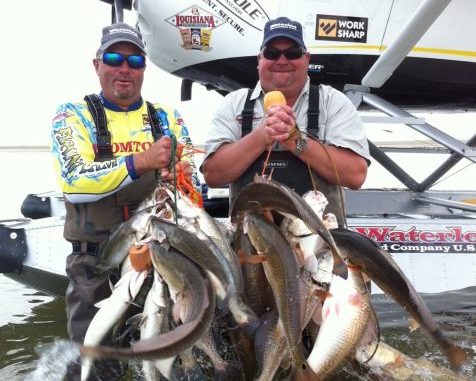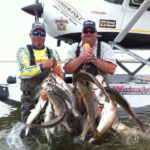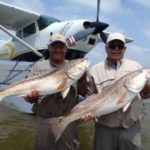
When Capt. Theophile Bourgeois was sitting in his high school Algebra 2 class contemplating what he wanted to be when he grew up, he probably wasn’t aspiring to become a pilot.
He was most likely dreaming about all the fish he would be catching from his boat.
Little did he know that steering and landing an airplane would soon become part of his career.
Bourgeois still spends a significant portion of his time in a boat, but when Mother Nature takes a deep breath, Bourgeois jumps at the opportunity to take his clients on a trip of a lifetime — by plane.
He flies out of his Lafitte-based lodge, heading to the Chandeleur Island chain to target massive bull redfish.
“As far as redfish at the Chandeleur Islands, it’s a 10 plus, if you can catch the conditions right,” Bourgeois said.
That’s a rare sight in the spring, the windiest season of the year.
“The problem is if the wind isn’t right and the conditions aren’t right it won’t work,” Bourgeois said. “In March, there are only a handful of days you can go.”
Understanding how the islands are constructed and knowing which wind directions are detrimental can help anglers decide when to sit by the fire at the house and when to do battle with redfish.
“The way the islands are set up, they run … from Biloxi and start scooping a half crescent toward the mouth of the (Mississipppi) river,” he said. “Gosier and Breton have grown tremendously, but it still doesn’t give you much protection from a north wind.”
Bourgeois said the wind direction is more of a factor than its speed. However, if it’s over 15 mph, he doesn’t go because it makes fishing difficult for clients — particularly novices.
Once he figures out a day that he can go, Bourgeois flies out to his predetermined island, and a lot of days sees thousands of redfish.
“It’s nothing to go out there and see 5,000 or 10,000 bull redfish all stacked up along the Chandeleur Chain,” he said.
Bourgeois simply wades around until he sees schools of fish. This is definitely easier on a calm day, when anglers can easily see the bulls.
Bourgeois throws a variety of lures.
“You can throw anything and they’ll eat it,” he said. “They’re starving and ready to eat.”
Bourgeois, a topwater enthusiast, said the fish are willing to hit his favorite lure, but for people who want a sure-fire technique he recommended something different.
“You can catch them on topwater; even though it’s cold, they’re still going to hit it,” he said. “Now, if it’s a cloudy day, I’m not even going to bother with it. I’m going to throw plastic at them because with the plastics, even if the fish is not hungry you can entice him into biting.”
Bourgeios uses a ¼-ounce jighead teamed with a Yum Mud Minnow, and he said color doesn’t matter.
In the early spring months, you wouldn’t think you would find redfish around the shallow water of the islands, but Bourgeois said they are there for good reason.
“In the winter months, you’ll find speckled trout in a deeper canal because the fish want a stable water temperature,” he said. “It’s just the opposite with the redfish — they’ll go to the shallow parts, which is the barrier islands.”
For anglers who get up early for work every day, sleeping in on the weekends is nice — but that’s not always possible with a fishing addiction stronger than Junior Dos Santos.
But waking up early will only hinder your success, according to the veteran guide.
“Between 9 a.m. and 2 p.m., the redfish will have their backs out the water,” Bourgeois said. “They want the sun to heat them up.”
Bourgeois said the shallow water is remarkably warmer, making the reds much more active.
“You almost feel a 20-degree difference,” he said.
As far as the equipment, Bourgeois grew up fishing with big reels and big surf rods. With today’s modern technology, however, he gets away with lighter equipment.
“I try to catch the biggest fish on the lightest rod,” he said.
Bourgeois uses a 2500 series reel spooled with 15-pound braid and a medium-power Waterloo rod.
“The reason I use such a light braid is because I need to carry 150 yards of line,” he said. “I have my drag as tight as I can to try to shorten the fight up. Since the fish are cold, they’re going to do a third of the pull they do in June and July.”
In the summer months, Bourgeois steps up to bigger gear.
“In June and July, you have to go to a 3500 series reel because you can’t stop them with something smaller,” he said.


